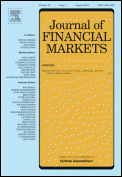
JOURNAL OF FINANCIAL MARKETS
Scope & Guideline
Illuminating the complexities of financial markets.
Introduction
Aims and Scopes
- Market Efficiency and Price Discovery:
Research often investigates how information and trading strategies impact market efficiency and the mechanisms of price formation, including the role of liquidity and trading costs. - Behavioral Finance and Investor Sentiment:
The journal addresses the influence of psychological factors and investor behavior on market movements, including studies on herding behavior, sentiment analysis, and the effects of media. - Regulatory Impact and Market Structure:
Papers frequently explore how regulatory changes and market structure (e.g., dark pools, high-frequency trading) affect market outcomes and participant strategies. - Quantitative Methods and Machine Learning:
The use of advanced quantitative methods, including machine learning, is a growing focus, with studies applying these techniques to predict market movements and analyze trading strategies. - Global Market Dynamics:
Research includes comparative analyses of international markets, examining how global events, economic indicators, and cross-border trading practices influence local market behavior. - Risk Management and Derivative Markets:
The journal publishes work on the relationship between risk management practices, derivatives trading, and their implications for market stability and investor behavior.
Trending and Emerging
- Algorithmic and High-Frequency Trading:
Recent publications highlight the growing role of algorithmic trading strategies and their impact on market efficiency, participant behavior, and regulatory considerations. - Machine Learning Applications:
There is a burgeoning interest in applying machine learning techniques to financial data analysis, with research focusing on predictive modeling and risk assessment. - Impact of Information Disclosure:
Emerging studies examine the effects of information dissemination on market dynamics, particularly how private information and news affect trading behaviors and price movements. - Sustainability and Climate Risk:
An increasing number of papers address the implications of climate risks on financial markets, reflecting a broader trend towards integrating sustainability into financial analysis. - Investor Behavior in Crisis Situations:
Research is increasingly focused on understanding how investor sentiment and behavior change during crises, such as the COVID-19 pandemic, highlighting the relevance of psychological factors in trading. - Cross-Market Interactions:
The exploration of interactions between various asset classes and markets is gaining traction, as researchers seek to understand the interconnectedness of global financial systems.
Declining or Waning
- Traditional Fundamental Analysis:
There appears to be a waning interest in purely fundamental analysis approaches, with more emphasis now placed on behavioral finance and quantitative methods. - Static Models of Market Behavior:
Research employing static models to analyze market behavior is becoming less common, as there is a shift towards dynamic models that account for changing market conditions and participant behaviors. - Historical Financial Events Analysis:
Studies focused solely on historical events without linking them to current market implications have decreased, as contemporary relevance and predictive insights take precedence. - Microstructure Studies in Isolation:
While market microstructure remains a critical area, papers focusing exclusively on microstructure without integrating broader market context or real-world applications are less frequently published.
Similar Journals
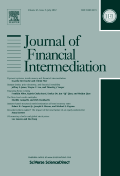
JOURNAL OF FINANCIAL INTERMEDIATION
Navigating the complexities of financial institutions.JOURNAL OF FINANCIAL INTERMEDIATION, published by Academic Press Inc Elsevier Science, is a premier academic journal dedicated to the study of financial intermediation. First established in 1990, this esteemed journal has firmly positioned itself within the top quartile (Q1) of rankings in both Economics and Econometrics as well as Finance, reflecting its significant impact and relevance in the field. With an impressive Scopus ranking of #31 out of 317 in Finance and #74 out of 716 in Economics and Econometrics, it caters to a diverse audience, including researchers, professionals, and students interested in the intricate dynamics of financial markets and institutions. While the journal does not currently offer open access, it remains a vital resource for disseminating cutting-edge research and insights that drive innovation and inform policy-making in the financial sector. With a commitment to maintaining high academic standards, the JOURNAL OF FINANCIAL INTERMEDIATION continues to serve as an essential platform for advancing knowledge in financial theories and practices.
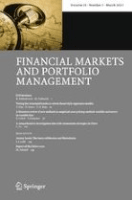
Financial Markets and Portfolio Management
Pioneering Research at the Intersection of Finance and Economics.Financial Markets and Portfolio Management is a renowned peer-reviewed journal published by Springer, focusing on the dynamic and evolving intersections of finance, economics, and accounting. With an ISSN of 1934-4554 and an e-ISSN of 2373-8529, the journal provides a platform for innovative research on financial markets, investment strategies, and portfolio management techniques. It boasts an impactful presence in the academic community, with a Scopus ranking placing it in the 58th percentile in Finance and the 51st percentile in Accounting, underscoring its significance in both fields. Spanning coverage from 2006 to 2024, the journal offers essential insights for researchers, practitioners, and students interested in the latest developments and empirical analyses in financial practices. Although it does not offer open access options, its rigorous editorial standards ensure high-quality content accessible to library and institutional resources. The journal plays a pivotal role in advancing knowledge and fostering dialogue in an increasingly complex financial landscape.
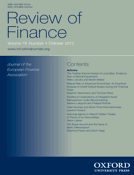
Review of Finance
Exploring the intersections of finance, accounting, and economics.The Review of Finance, published by Oxford University Press, stands as a premier academic journal in the fields of Finance, Accounting, and Economics. With an ISSN of 1572-3097 and an impressive track record stretching from 2001 to 2024, this journal is consistently recognized for its high-quality research, reflected in its Q1 rankings across key categories, including Accounting, Finance, and Economics and Econometrics. The Review of Finance is dedicated to advancing the understanding of financial phenomena through robust empirical and theoretical insights, making it an essential resource for researchers and professionals alike. Additionally, its strong Scopus rankings, placing it in the top percentiles, highlight its influence and relevance in ongoing academic discourse. Although the journal is not open access, it remains widely accessible through academic institutions, ensuring that its valuable contributions reach an extensive audience. The editorial board invites submissions that promise to further engage the academic community in the dynamic intersections of finance, accounting, and economic research.
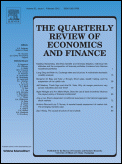
QUARTERLY REVIEW OF ECONOMICS AND FINANCE
Charting the Course of Economic InnovationQuarterly Review of Economics and Finance is a renowned academic journal published by Elsevier Science Inc. that focuses on key advancements in the fields of economics, econometrics, and finance. With a commitment to fostering scholarly dialogue, this journal provides a platform for researchers and practitioners alike to disseminate innovative ideas and empirical research, contributing to the economic discourse since its inception in 1992. Recognized for its quality, the journal holds an impressive Q2 ranking in both Economics and Econometrics and Finance, with Scopus rankings placing it in the 81st percentile, underscoring its relevance and impact within the scholarly community. While the journal operates under a subscription model, it boasts a global readership and is accessible to professionals and students seeking insightful and rigorous analyses of contemporary economic issues. With its clear objectives of expanding knowledge and influencing practice, the Quarterly Review of Economics and Finance serves as an essential resource for anyone committed to understanding the dynamics of economics and finance in the modern world.

EMERGING MARKETS FINANCE AND TRADE
Driving Research on Trade Trends and Economic PoliciesEmerging Markets Finance and Trade is a leading academic journal published by Routledge Journals, Taylor & Francis Ltd, specializing in the dynamic field of finance and trade within emerging markets. This journal boasts an impressive impact factor and ranks in the top quartiles of its categories, attaining Q1 status in Economics, Econometrics and Finance (miscellaneous) and Q2 in Finance as of 2023. With a strong focus on innovative research, it publishes cutting-edge studies and insights that are crucial for understanding the complexities of financial systems in emerging economies. The journal, with ISSN numbers 1540-496X and 1558-0938 for its electronic version, offers a platform for both established researchers and newcomers in the field, highlighting the latest trends, policies, and challenges in finance and trade from 2002 to 2024. While it maintains a subscription-based access model, its significant contributions make it a must-read for academics, professionals, and students alike who seek to navigate and influence the rapidly evolving landscape of emerging markets.
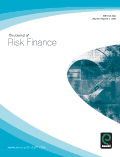
Journal of Risk Finance
Driving innovation in risk finance scholarship.The Journal of Risk Finance, published by Emerald Group Publishing Ltd, is a premier academic journal dedicated to advancing the understanding of risk management and finance practices since its inception in 1999. With a strong foothold within the Q2 rankings in both Accounting and Finance categories, it proudly holds a significant place in the scholarly landscape, ranking #54 out of 317 in the Scopus Economics and Finance category, placing it in the 83rd percentile. The journal aims to facilitate the exchange of innovative research and practical insights, catering to an audience of researchers, professionals, and students eager to explore contemporary issues in risk finance. While not an open access journal, it provides numerous access options, ensuring that essential findings reach a broad readership. Set in the United Kingdom and covering publications up to 2024, the Journal of Risk Finance continues to be an indispensable resource for those committed to this critical field.
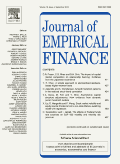
Journal of Empirical Finance
Illuminating financial truths through empirical exploration.Journal of Empirical Finance, published by Elsevier, stands as a key resource in the areas of finance and economics, with a definitive focus on empirical studies. As a prominent journal since its inception in 1993, it has made significant strides in contributing to the academic community, evidenced by its soaring categorization in Q1 for Finance and Q2 for Economics and Econometrics as of 2023. With an ISSN of 0927-5398 and an E-ISSN of 1879-1727, the journal emphasizes robust, data-driven analysis to inform both theoretical and practical aspects of financial research. While access options do not include open access, the journal ensures that its content remains accessible to a diverse audience of researchers, professionals, and students. It fosters a platform for innovative research and discourse, significantly impacting the fields of finance, economics, and econometrics. The Scopus rankings further bolster its reputation, placing it in the 61st percentile in both categories, reflecting a commitment to high-quality research output. As the journal continues to evolve, it invites contributions that push the boundaries of empirical finance, enabling a deeper understanding of financial mechanisms that drive global economies.
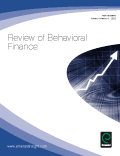
Review of Behavioral Finance
Bridging the Gap Between Psychology and Financial PracticeReview of Behavioral Finance is a distinguished journal published by Emerald Group Publishing Ltd, focusing on the dynamic interplay of psychology and finance. With an ISSN of 1940-5979 and an E-ISSN of 1940-5987, this journal serves as a pivotal platform for researchers, professionals, and students keen on exploring innovative behavioral financial practices. Operating from the United Kingdom, the journal has made significant strides since its inception in 2009, converging years up to 2024. It is well-regarded in its field, achieving Q2 rankings in Accounting, Finance, and Strategy and Management for 2023, reflecting its influential contributions to these domains. The journal's rigorous peer-review process guarantees the quality of published research, making it an essential resource for academics seeking to enhance their understanding of behavioral finance. While the journal does not currently offer open access, it remains accessible through various academic databases, facilitating the dissemination of vital financial insights. Engage with the cutting-edge research that shapes the future of finance today!
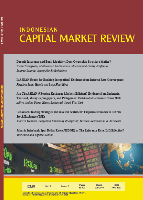
Indonesian Capital Market Review
Empowering Insights into Southeast Asia's Capital MarketsIndonesian Capital Market Review is a prominent academic journal dedicated to the exploration of financial markets, investment strategies, and economic policies within Indonesia and Southeast Asia. Published by Universitas Indonesia, this journal has been an essential resource for researchers, professionals, and students since its inception in 2009, offering open access to its content to promote wider dissemination of knowledge. With an ISSN of 1979-8997 and an E-ISSN of 2356-3818, it aims to bridge the gap between theoretical frameworks and practical applications in the capital markets. By rigorously vetting its publications, the journal enhances the academic discourse surrounding financial systems, thereby empowering stakeholders with empirical insights. The commitment to open access ensures that groundbreaking research is readily available to a global audience, advancing the understanding of capital market dynamics in Indonesia and beyond.
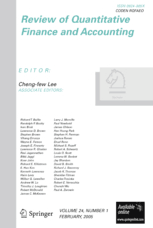
Review of Quantitative Finance and Accounting
Exploring the Intersection of Finance and AccountingThe Review of Quantitative Finance and Accounting, published by Springer, is a distinguished academic journal that has been at the forefront of scholarly discourse since its inception in 1991. With an ISSN of 0924-865X and an E-ISSN of 1573-7179, this journal specializes in the interdisciplinary realms of accounting and finance, particularly emphasizing quantitative methodologies and their applications in real-world scenarios. With an impressive track record reflected in its 2023 rankings, it sits in the Q2 category across key fields such as Accounting, Business Management, and Finance, demonstrating its relevance and influence within these domains. Although it operates without an Open Access option, the journal's content remains vital for researchers, professionals, and students aiming to deepen their understanding of quantitative approaches in finance and accounting contexts. The Review of Quantitative Finance and Accounting stands as an essential resource for advancing knowledge and fostering innovation within these critical disciplines.